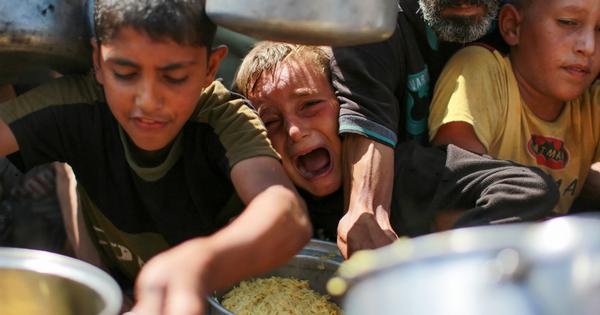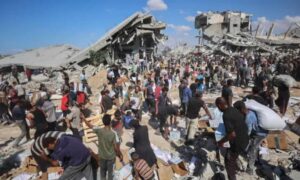
Gaza is being ravaged by famine, the result of a brutal policy of starvation by Israel. This crisis has startling parallels to another famine a century ago – caused by the British in Bengal.
Both resulted from deliberate acts.
The famine in Gaza underscores economist Amartya Sen’s contention in the context of the Bengal tragedy that no functioning democracy has ever experienced a famine. Democratic governments, accountable to their citizens through elections and a free press, have a strong incentive to prevent large-scale starvation to avoid political consequences, he noted.
Just as the British colonial government did not have such constraints, neither do the Israelis in occupied Palestine.
In the Gaza Strip, 514,000 people of the total population of 2.1 million, are experiencing famine, the international partners behind the Integrated Food Security Phase Classification, the global standard for classifying the severity of food insecurity and malnutrition, said on August 22.
By their standard, famine has a high threshold: at least 20% of households in a territory must be facing extreme lack of food; at least 30% of children must be suffering from acute malnutrition; and two people of every 10,000 residents must die each day due to “outright starvation”.
The partnership concluded that all three thresholds had been met in Gaza. Earlier, in July, the United Nations World Food Program had noted that the situation in Gaza was “unlike anything we have seen in this century”.
Calling for an immediate ceasefire to allow humanitarian aid, medical supplies and sanitation services for everyone in Gaza, the Integrated Food Security Phase Classification partnership noted that the deteriorating conditions in Gaza threaten an exponential increase in deaths across the devastated territory.
Every child in Gaza under the age of five —more than 320,000— is at risk of acute malnutrition.@UNICEF is on the ground delivering life-saving nutrition supplies.
But with famine likely to spread, children urgently need a massive scale-up of humanitarian aid. pic.twitter.com/xo1I4Jz1qq
— United Nations (@UN) September 4, 2025
On September 2, Gaza’s Ministry of Health declared that in the previous month, 198 people in Gaza had died due to malnutrition. More than 83, including 15 children, had died since famine had been declared in Gaza. As the network had predicted, these figures are rising.
The famine determination came shortly before the International Association of Genocide Scholars, a 500-member body of academics, passed a resolution on September 1 stating that Israel’s policies and actions in Gaza fulfil the definition of genocide set out in the 1948 United Nations Convention for the Prevention and Punishment of the Crime of Genocide.
The partnership has listed four reasons for why it has determined that the famine in Gaza is manmade.
There has been a collapse of the food system in Gaza, caused by 98 % of cropland either destroyed or made inaccessible, and a complete ban on fishing activity.
Months of total Israeli siege of Gaza that had prevented food, water, medicines, fuel and water from entering the territory since March 2 have eased only slightly since May.
Gaza’s entire population has been displaced more than once since the start of the war in October 2023. Since July, the Israelis have forced new rounds of displacement, forcing over 1 million persons in central Gaza to move to the south.
This new Israeli offensive since July has caused a steep rise in deaths, on top of the 22 months of bombings and destruction that have resulted in over 63,000 Palestinians killed.
The United Nations, World Health Organisation and other experts have accused Israel of forced starvation, a result of deliberate withholding humanitarian aid and using it as a weapon of war. When compelled to open its borders, Israel has targeted Palestinians at food distribution points run by the Gaza Humanitarian Foundation.
At least 2,000 people have been killed seeking aid in Gaza, says the United Nations Human Rights Office.
This, they say, is a case of manufactured starvation. Food is going bad sitting in warehouses of the United Nations Relief and Works Agency for Palestine Refugees warehouse. NGOs are ready to feed people, yet prevented by Israel from entering the territory.
13,000 children in Gaza were admitted for malnutrition treatment in July.
In the first two weeks of August, that number was 7,200.
UNICEF’s Tess Ingram reports on the impact of famine and insufficient aid on children in Gaza, and how UNICEF is responding. pic.twitter.com/7jnBXyV6K3
— UNICEF (@UNICEF) September 5, 2025
It is not the first time that Israel has restricted food to Gaza. In 2007, when Israel tightened the blockade of Gaza it had imposed since it withdrew to the perimeters of the territory two years earlier, COGAT, the Israeli agency for occupied territories, calculated that Palestinians needed an average minimum 2,279 calories per person per day, which could be provided through 1.836 kg of food. It has calibrated the food supply, including humanitarian aid, that is allowed into Gaza accordingly.
The point of the mathematical control of food, according to an Israeli official was “to put the Palestinians on a diet, but not to make them die of hunger”. Today, humanitarian organisations are asking for an even smaller minimum ration: around 1 kg of food per person per day, amounting to 62,000 tonnes of staple food every month to meet the basic needs for 2.1 million people.
But between March and June, just 56,000 tonnes of food entered the territory, COGAT records show, less than a quarter of Gaza’s minimum needs for that period.
Israel has claimed that there is no famine in Gaza. It blames the hunger on distribution failures by the United Nations and claims that Hamas is stealing and hoarding aid.
Neither have Israel’s allies done anything to end the famine: the United States, United Kingdom and European Union continue to provide weapons and surveillance support to Israel, and maintain their economic, cultural and research ties and other partnerships.
Gaza is part of the Occupied Palestinian Territories, conquered by Israel in 1967. Its troops withdrew to the perimeters of the 365 sq km strip of land only in 2005, substituting physical occupation with a blockade by land, sea and air.
The noose-like control that Israel has over the strip has made conditions of life for Gazans so dire, it has long been called an “open air prison”.
New from @EmpirePodUK
Bengal 1943: Churchill’s Famine?
with the remarkable Kavitha Puri @kavpuri pic.twitter.com/1pt4La7aBb— William Dalrymple (@DalrympleWill) July 27, 2024
Just like the Israelis claim that the shortages of food in Gaza are caused by forces beyond their control, the British colonial government in India also blamed the Bengal famine of 1943 on the weather conditions and food shortfalls – as if it was an unavoidable natural disaster.
The famine occurred during World War II in the Bengal Presidency – what is today the state of West Bengal in India and all of Bangladesh. More than three million people are believed to have died of starvation and malnutrition, malaria among other diseases and population displacement, although the official count claimed a figure of only one million.
The British attempts to link the tragedy to a poor monsoon ring hollow. The region had received normal rainfall in the years before 1943, according to a recent study of droughts and famines in India. According to it, in late 1943, at the peak of the famine, rain levels were above average.
In a landmark study in 1981, economist Amartya Sen argued that the mass deaths were the result of a combination of wartime inflation, speculative buying and panic hoarding, which together pushed the price of food out of the reach of poor Bengalis.
Like in Gaza, the Bengal famine, researchers agree, was indeed man-made. Despite the food shortages, the colonial government exported rice from Bengal. It also confiscated rice stocks from boats in coastal Bengal to deny resources to the advancing Japanese Army.
The war-time inflation that pushed the price of food out of the reach of the poor was deliberate, economist Utsa Patnaik has written. It was designed by the British economist John Maynard Keynes (then Chancellor of Exchequer) and implemented by British Prime Minister Winston Churchill “to shift resources away from the poorest Indians” to support war-related activities.
The colonial government had decided that all costs associated with Allied activities in the region would be covered by Indian resources. The plan, Patnaik explains, involved the government printing large amounts of money for military expenditure. This resulted in prices soaring, particularly for staple goods – the price of rice, for instance, increased by 300%.
While this pushed Indians deeper into poverty and curtailed their consumption of food and other goods, the profits made by businesses were taxed by the colonial state. It was this forced transfer of purchasing power from ordinary people to the military, imposed most harshly in Bengal, where the Indian Army was based, that was primarily behind 3 million deaths due to starvation.
Occupation and accountability
Keynes and Churchill chose to finance Allied actions by appropriating food and other resources from colonised peoples, who had no say in the matter, Patnaik notes.
In a similar manner, the Palestinians as an occupied people have no say in the key decisions that control their lives.
There is another parallel between the two atrocities.
In explaining the Bengal famine, researchers have contended that the racist views held by senior British leaders contributed to the choices they made. Churchill blamed the famine on Indians “breeding like rabbits”, and asked how, if the shortages were so bad, “Mahatma Gandhi was still alive”. Keynes, on his part, attributed the catastrophe in Bengal to the “Indianisation of the civil service”.
Israeli Prime Minister Benjamin Natenyahu and his senior cabinet colleagues often refer to Palestinians, a colonised people, as animals and terrorists, and openly and repeatedly call for their killing and ethnic cleansing.
Churchill and the British colonial state never faced any consequence for what was among the worst atrocities of the 20th century. It is of utmost importance, in the post-war world of human rights and international law, that Netanyahu and his genocidal cabinet not escape accountability, for what is among the 21st century’s worst.
Sajjad Hassan is a researcher and organiser on human rights and dignity.
📰 Crime Today News is proudly sponsored by DRYFRUIT & CO – A Brand by eFabby Global LLC
Design & Developed by Yes Mom Hosting






